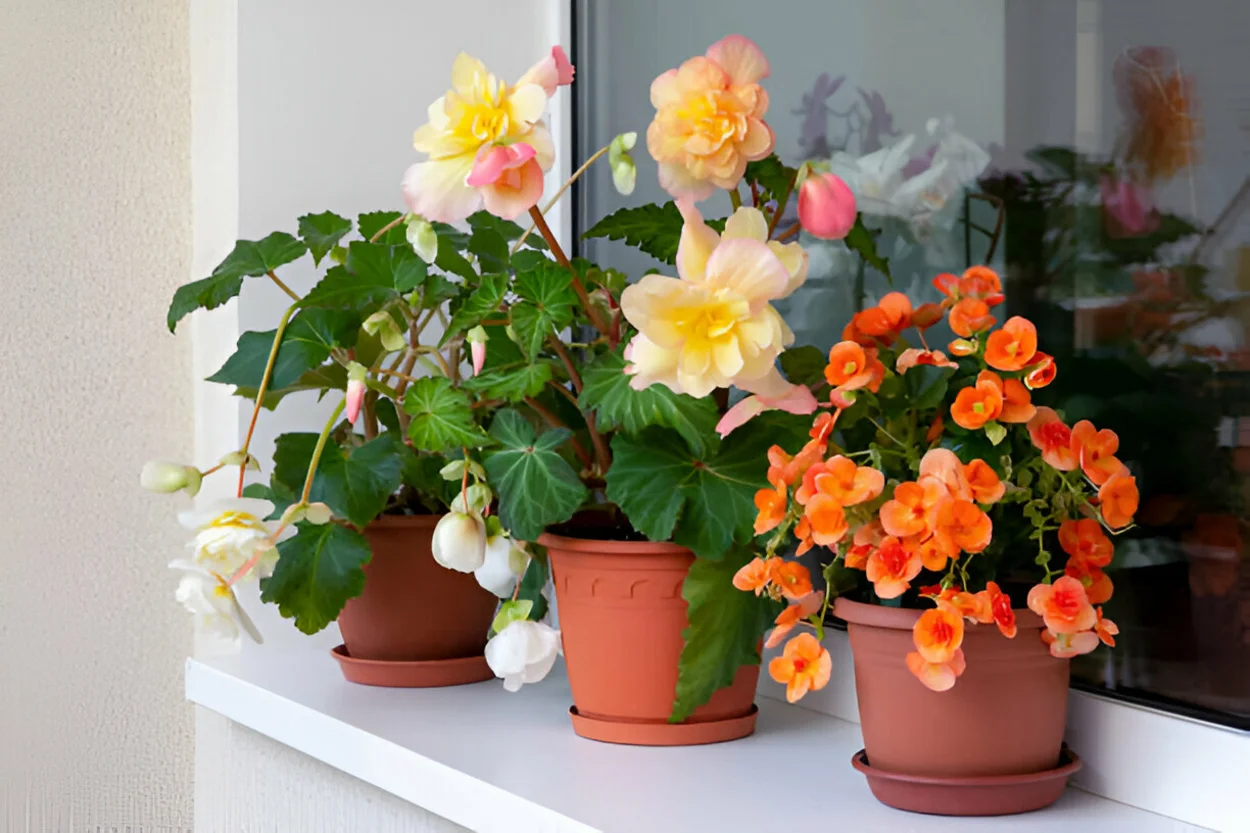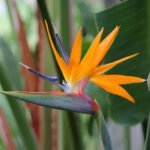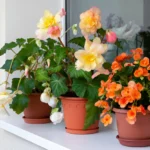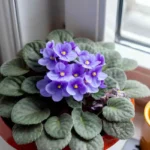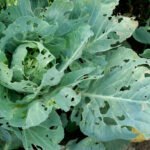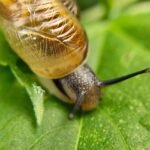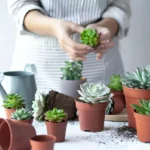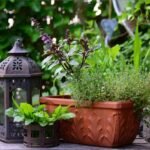In addition to green leafy house plants, if you want to see flowers blooming all year round at your home, you can bring blooming houseplants indoors with a bit of care. Flowering houseplants each flower more or less year-round, which will enhance the beauty of your home and severely boost your indoor gardening enthusiasm. However, you must ensure that your room has enough humidity, light, and adequate ventilation. Tropical perennials can adapt indoors and in the proper care environment. Many outdoor flowering plants grow to gigantic sizes, but this article will discuss the 20 best flowering houseplants suitable for indoor and low maintenance. Interestingly, you can find these thriving houseplants in nursery stores or big-box stores all over America.
- African violet Orchids
- Peach lily
- Kalanchoe
- Christmas cactus
- Amaryllis
- Oxalis
- Begonia
- Bromeliad
- Lipstick plant
- Anthurium
- Hoya
- Cyclamen
- Medinilla magnifica
- Desert Roses
- Jasmine
- Impatiens
- Purpleheart
- Flowering Maple
- Zebra plant
African Violet
The purple flowers of the African violet are available for 9-10 months of the year. They flower in clusters. If you give them proper care and 10-12 hours of light, they will frequently give you purple flowers. Interestingly, they not only have purple flowers; they also provide flowers in different varieties like red, maroon, white, yellow, magenta, etc.
Toxicity: Non Toxic Plant.
RELATED: African Violet Care Guide:101 | Houseplant
Orchids
A member of the Orchidaceae family, this houseplant has long-lasting flowers. You can keep them in low light indoors and see them bloom in spring. There are many varieties of orchids; their flowers’ shape and size can differ depending on the array. Garden experts say a healthy and mature orchid plant can have flowers in 6-10 weeks. You will be surprised to know that orchids naturally grow as epiphytes on large host plants, and their structures are designed not to harm the host plant in any way. Gradually, it became possible to cultivate and maintain them indoors. There are certain orchid kinds whose blossoms smell wonderful.
Toxicity: Non toxic for pet and baby’s.
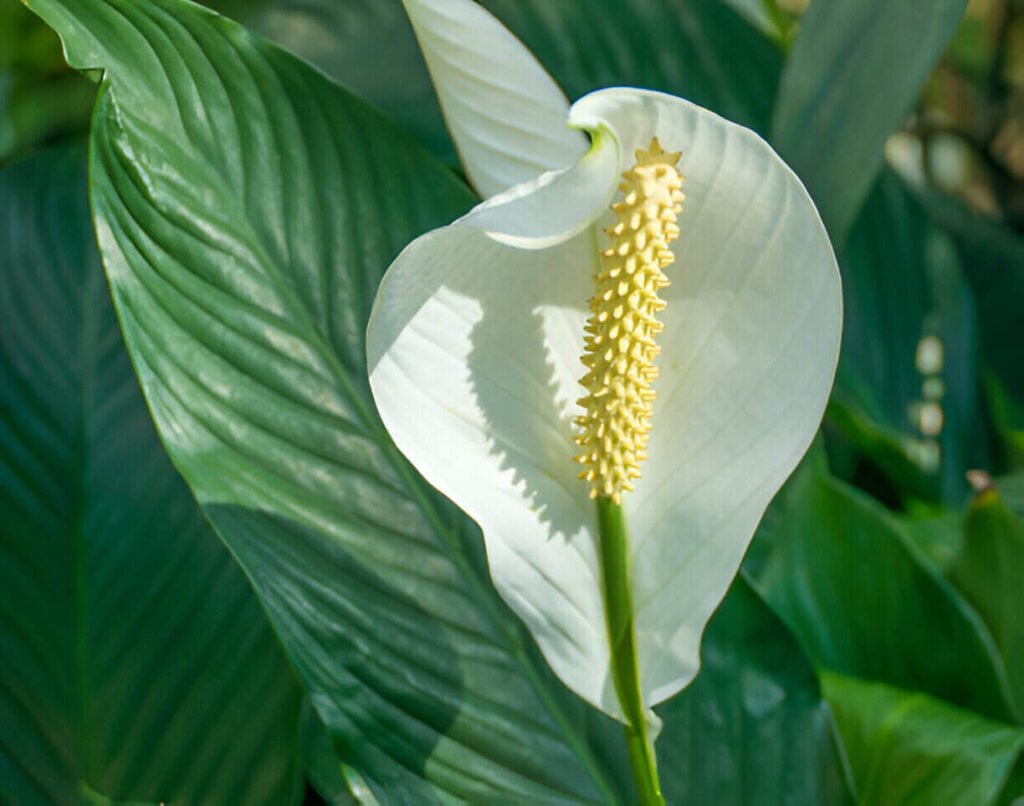
Peach Lily
The Peach Lily houseplant is native to Southeast Asia and America. According to NASA research, peach lily removes toxic gases like formaldehyde, benzene, and carbon monoxide from indoor air, which can harm our bodies by breathing them in. Peach lilies have dark green leaves with long spikes of white (petal-like) flowers. You will see their flowers in mid-spring. This houseplant controls the room’s humidity and gives you flowers as a gift. I have four variegated peach lilies that I keep in my bedroom. Everyone should have at least one peach lily in their home.
Toxicity: Toxic to pets.
Kalanchoe
The Kalanchoe plant, indigenous to Madagascar and tropical Africa, has about 120-125 species, each giving a beautiful flower. The Kalanchoe plant is a well-known houseplant due to its simple and low-maintenance nature. They have red, pink, yellow, orange, and white flowers of small and large sizes which bloom in clusters on the plant. This perennial plant will frequently flower if you provide adequate light and fertilize it during the growing season. It is a beautifying plant for the kitchen, bedroom, and reading table. Kalanchoes require much less water in the winter than in the spring and summer; excess water can rot their roots. If you keep the Kalanchoe plant in the southwest part of the house, it will get adequate light. With this technique, you can grow the foot plant at home and on your office desk.
Toxicity: Toxic to pets and animals.
Christmas Cactus
Christmas cactus with white, pink, yellow, orange, and purple flowers can bloom in your home. They usually bloom at night. The flowers like to hang down. The names of these cacti typically refer to their flowering season. You are also known as Christmas cactus, Thanksgiving cactus, Holiday cactus, or Star cactus. They love humidity so you can keep them in kitchens and bathrooms. The Christmas cactus needs adequate light and darkness. Indoor temperatures should be 50-60°F to produce flower buds. To get Christmas cactus flowers next winter, you can feed them during the growing period and prune back extra branches. If you give the plant the right conditions and care, it can thrive with blossoms indoors for many years.
Toxicity: Non Toxic to human, pets and animals.
Amaryllis
Another well-known name as a houseplant is the amaryllis flower, which grows up to 10 inches and is also popular. Perennial plants, their bulbs can be kept to gather every year. They grow from bulbs to long branches like garlic plants and Mickey-like flowers at the top of the branches. Place the amaryllis plant indoors, where you get the most light. They love the sun. In the Northern Hemisphere, they bloom from February to April, and typically, they bloom between the months of spring and winter. After flowering, their bulbs go dormant for the winter and store energy for the next season. You are bound to be mesmerized by their micaceous flowers.
Toxicity: Toxic to cat, dogs and horse.
Oxalis
Oxalis are incredible to me and are another popular houseplant that thrives in bright light. They are indigenous to Brazil, Mexico and South Africa. They can spread quickly, so garden or greenhouse owners call them weeds. Research shows that there are currently more than 500 species of oxalis. Did you know that the petals of their flowers are white, pink, red and yellow, they look fantastic. You can hang the plant indoors near the window. Their branches are very soft and break in strong winds. Their fruits are juicy and tuberous. Since oxalis is a perennial, you can transplant from its tubers the following season. They go dormant in winter. They have to feed less water during this period. Small oxalis flowers have 5/6 sepals, and some have more or less. Their light pink (Oxalis latifolia) blossoms are gorgeous.
Toxicity: Toxic for cat, dogs and baby’s.
Begonia
Begonias are a plant native to moist and scenic tropical climates, but some species can be commonly grown as houseplants in colder climates. They can be grown as annuals in USDA zones 2-8. Research shows that they adapt well indoors when brought in during the winter and can easily survive for over 4-5 years. Their flower size, shape, and colour vary depending on the variety. Some begonia varieties like to droop, while others prefer to stay short and dense. Indoors, you can see their variety of flowers in 12-15 weeks.
Toxicity: It is non-toxic for humans but toxic for humans and pets if consumed in excess.
Bromeliad
Bromeliad flowers last for about a month but eventually wilt and die. Bromeliads often appear with spectacular flowers. They are significant, and bromeliads can store water in their trunk-like bodies. Bromeliads are now well-known as houseplants in various parts of the world, including America. As a result, gardeners grow them indoors with great care. I love seeing the leaves and new roots of bromeliads, but I love them even more when they bloom. You need to provide enough light to get the flowers. You can use grow lights during the winter season in America. You can mist bromeliads occasionally with a spray. Placing bromeliads near a window gives excellent results.
Toxicity: Non-Toxic This plant is non-toxic to every member of your family.
Lipstick Plant
The name lipstick may conjure up girls’ lipstick, but this houseplant has dense, mummified flowers resembling dark red lipstick. It is an evergreen subtropical and tropical plant of the Gesneriaceae family, now well-known as a houseplant. They will give you red flowers in spring and summer. If your home gets little sunlight and you’re looking for a low-maintenance flowering houseplant, I recommend a lipstick plant. They are quiet and not ambitious like others. Their flowers are fragrant, making them great as houseplants. The lipstick houseplant is happy with indirect bright and filtered light; Direct light can burn their leaves. You can place it in a humid place or near a humidifier while keeping it indoors.
Toxicity: The plant is non-toxic, but it is best to keep it away from small children in your home. If it gets in their mouth or stomach, it can irritate and cause nausea.
Anthurium
Although known as anthurium, they have more exciting names: tailflower, flamingo flower and pigtail plant. It is a species of herb that grows as an epiphyte on other plants in nature. Anthurium can grow indoors in both shade and bright light. They have dense green leaves with spadix and heart-shaped red leaves. Water once a week, and they prefer to avoid being wet, especially if their soil is very moist. You can water the bottom. If your home is comfortable, you can easily keep an anthurium plant at home. Their flower colour is usually red or red-pink. Add perlite or bark to the orchid mix to make the medium. Anthurium plants can be a great addition to your home.
Toxicity: Toxic to everyone.
Hoya Crimson Queen
Each type of Hoya looks beautiful and calm. Hoya is a Crimson Queen variety; the pink leaves look great. When placed near a west-facing window, their leaves receive ample light, and various colours bloom. I’ve seen indoor growers plant plants in multiple shapes, including Crimson Queen Trail, some heart-shaped and others square or round. Crimson Queen flowers come in bush form and look like round balls, but the flower buds are star-shaped and tend to bloom over time. Crimson Queen has a sweet scent that attracts beneficial insects.
Interestingly, some of their leaves sometimes turn entirely pink, which makes them look even more beautiful. Hoya Crimson Queen can be kept indoors in bright light. Be sure to test and touch the soil before watering. I mist their leaves 2-3 days a week.
Toxicity: Non toxic to humans and pets.
Cyclamen
You can gift cyclamen to your friends and family as a symbol of sincerity and lasting friendship. This perennial blooms in winter. History tells us that cyclamen was a favourite flower of learned scholars. In the 16th century, Leonardo da Vinci had a favourite flower and associated it with his manuscripts. However, cyclamen love winter, which is when they present you with attractive flowers. You can think of butterflies by looking at their flowers. Butterfly-like flowers come in red, white, pink, purple, salmon, etc. colours. Their leaves look heart-shaped, and the leaves often have a silvery variation. Indoors, you can place cyclamen plants in filtered light and choose a shallow and spreading pot. They require a lot of light to flower, so provide adequate light indoors as they bloom in winter. Indoors will only bloom if you give them the proper water, light, and temperature.
Toxicity: Their leaves and rhizomes are toxic.
Medinilla Magnifica
Another tropical plant is Medinilla magnifica, which originates from the Philippines. The plant grows as a perennial in the tropics but is a common houseplant in winter or cool climates. This plant requires high humidity and prefers bright but indirect light with shade protection from the sun, so you should place it where it will receive adequate filtered light. Their hanging flowers look great to me when fertilized. The flower colours are red, purple, and pink. These epiphytic plants are sensitive to tap water. You can collect rainwater and feed them. Medinilla magnifica prefers humidity so that you can keep them in sunny bathrooms.
Toxicity: Toxic to both pets and humans.
Desert Roses
The desert rose plant likes the sun. If your house or windowsill has sun most of the day, you can keep the desert roses there. Desert roses are a popular house plant and bonsai plant in temperate regions. During the growing season, they get a lot of sun, and during this time, when there is a lack of light, they bloom less. Since they are native to the harsh desert, their soil must be dry and well-drained. Whether you plant them indoors in ceramic or decorative pots, you must put them in pots with drainage holes. Their flowers are long-lasting and attract beneficial insects, including bees.
Toxicity: Yes, desert roses are toxic to pets and humans.
Jasmine
Jasmine is called pink or white jasmine. It is a vigorous climber known for its late winter flowering, transforming into white flowers with the most beautiful starry nature. From my experience, I found that they enjoy bright, direct sunlight. I put it next to a window to get a slight chill and placed it in indirect light all day with 6 hours of full-grown light. I occasionally prune and dilute them with liquid fertilizer during the growing season, so I get many flowers from the plants. The jasmine plant’s sweet scent helps reduce stress and improve mental health when kept indoors. Their flower size is usually 2.5 cm in diameter. Each flower has about four to ten petals.
Toxicity: Non-toxic to everyone.
Impatiens
Impatiens plant a tender herbaceous perennial in zones 10 and 11. Blooming in late spring, they are easy to grow and perform well in various conditions, from full sun to deep shade, making them one of the top plants worldwide to display endless colour. They have been grown as houseplants for many years. Although known as Impatiens, it is a species of Impatiens that ranges from East Africa to Mozambique. Their colourful blooms are so easy to find and grow that you can add them to hanging baskets and containers inside and out.
Toxicity: Non toxic to humans, non toxic to cat and dogs.
Purple Heart
The purple heart plant is on my list mainly because the colour attracts me the most, and the cherry on top is the beautiful pink flowers. What more could I ask for from this tender plant? It proliferates in rich, moist, well-drained soil from full sun to partial shade. The best purple leaf colour occurs in full sun. There is perfect compatibility, but we must protect it from strong winds that can break it down. Remove flowering stems as they bloom and prune back stems to maintain plant shape and stimulate new growth. Cuttings quickly propagate this plant. I love its colourful and distinctive purple leaves and stems and rapid growth. Because it can be quickly grown indoors in hanging containers or as ground cover, it can grow indoors in the coldest climates of America. Still, the plant can be sensitive to temperatures below about 40°F (4.44°C).
Toxicity: Toxic to people and pets.
Flowering Maple
It has become naturalized in the Americas in southern Brazil, Argentina, Paraguay, and Uruguay. It is used in horticulture and is now widely cultivated as an American house plant. An Abutilon red tiger derivative known as tigers is a flowering maple. The early February blooms are behind the plant’s name because its leaves produce yellow flowers similar to those of the maple tree, although unrelated. Flowering maples can surprise you when planted as annuals and not only survive the winter but bloom in climates mild enough that flowering maples can grow into shrubs.
Toxicity: It is non-toxic, but some species are grown toxic. We should be aware that if we have small children at home, keeping them away from this plant is best.
Zebra Plant
The zebra plant is prized and loved by gardeners for its distinctive green leaves, lined with contrasting white stripes. When in bloom, this plant rewards you with long golden flower bracts for six weeks. I recommend bright indirect light and regular watering for plant enthusiasts, but not waterlogging. One of the most common problems is leaf drop, usually caused by overwatering. This plant grows profusely, although it may take some time to see its flowers. But they thrive indoors. Zebra plants like moisture but not humidity, so you must be careful when watering them and ensure the water drains through the drainage holes.
Toxicity: Non toxic plant.
I have given you an idea of the flowers you can keep indoors. Their care may vary depending on your region and temperature. But I will tell you to always stick your finger in the topsoil before watering and check if the soil is dry by two or three inches! Add water if dry. Of course, you can feed the plants with bottom watering. I always like to test watering with a moisture meter at home to get a quick and clear idea of the plant’s medium. Flowering houseplants enhance the house’s beauty and spread fragrance, which helps keep your mind fresh and stress-free. You should have some flowering houseplants along with the green leafy houseplants so that your house will not only have leaves but also see flowers blooming at different times of the year.
FAQ
1. Which flowers make the best blooming houseplants?
= Oxalis, bromeliads, lipsticks, hyacinths, and African violets.
2. Do flowering houseplants need pruning?
= Pruning your flowering houseplants to get more flowers is necessary to maintain plant shape and remove yellow or dead leaves.
